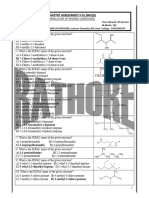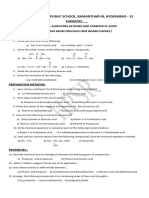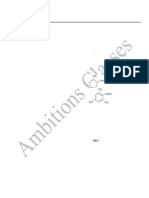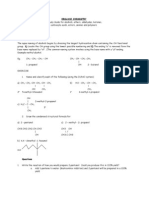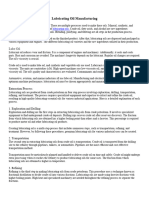0 ratings0% found this document useful (0 votes)
638 viewsTutorial 8 Chapter 8: Carboxyl Compounds: Chm207 (Organic Chemistry)
Tutorial 8 Chapter 8: Carboxyl Compounds: Chm207 (Organic Chemistry)
Uploaded by
Eqieyn JerrThis document provides an organic chemistry tutorial on carboxylic acid compounds. It includes questions asking students to name carboxylic acid compounds using IUPAC nomenclature, draw structural formulas, rank acid strengths, identify suitable reagents for reaction mechanisms, predict products of reactions involving carboxylic acids, and convert functional groups. The tutorial covers key concepts about carboxylic acids including nomenclature, acid strength, reactions such as esterification, hydrolysis, oxidation, and reduction.
Copyright:
© All Rights Reserved
Available Formats
Download as PDF, TXT or read online from Scribd
Tutorial 8 Chapter 8: Carboxyl Compounds: Chm207 (Organic Chemistry)
Tutorial 8 Chapter 8: Carboxyl Compounds: Chm207 (Organic Chemistry)
Uploaded by
Eqieyn Jerr0 ratings0% found this document useful (0 votes)
638 views4 pagesThis document provides an organic chemistry tutorial on carboxylic acid compounds. It includes questions asking students to name carboxylic acid compounds using IUPAC nomenclature, draw structural formulas, rank acid strengths, identify suitable reagents for reaction mechanisms, predict products of reactions involving carboxylic acids, and convert functional groups. The tutorial covers key concepts about carboxylic acids including nomenclature, acid strength, reactions such as esterification, hydrolysis, oxidation, and reduction.
Original Description:
chm
Original Title
Tutorial 8
Copyright
© © All Rights Reserved
Available Formats
PDF, TXT or read online from Scribd
Share this document
Did you find this document useful?
Is this content inappropriate?
This document provides an organic chemistry tutorial on carboxylic acid compounds. It includes questions asking students to name carboxylic acid compounds using IUPAC nomenclature, draw structural formulas, rank acid strengths, identify suitable reagents for reaction mechanisms, predict products of reactions involving carboxylic acids, and convert functional groups. The tutorial covers key concepts about carboxylic acids including nomenclature, acid strength, reactions such as esterification, hydrolysis, oxidation, and reduction.
Copyright:
© All Rights Reserved
Available Formats
Download as PDF, TXT or read online from Scribd
Download as pdf or txt
0 ratings0% found this document useful (0 votes)
638 views4 pagesTutorial 8 Chapter 8: Carboxyl Compounds: Chm207 (Organic Chemistry)
Tutorial 8 Chapter 8: Carboxyl Compounds: Chm207 (Organic Chemistry)
Uploaded by
Eqieyn JerrThis document provides an organic chemistry tutorial on carboxylic acid compounds. It includes questions asking students to name carboxylic acid compounds using IUPAC nomenclature, draw structural formulas, rank acid strengths, identify suitable reagents for reaction mechanisms, predict products of reactions involving carboxylic acids, and convert functional groups. The tutorial covers key concepts about carboxylic acids including nomenclature, acid strength, reactions such as esterification, hydrolysis, oxidation, and reduction.
Copyright:
© All Rights Reserved
Available Formats
Download as PDF, TXT or read online from Scribd
Download as pdf or txt
You are on page 1of 4
CHM207 (ORGANIC CHEMISTRY)
TUTORIAL 8
CHAPTER 8: CARBOXYL COMPOUNDS
1)
Give the IUPAC names of the following compounds:
a) CH3CH2CH(CH3)COOH
b) CH3CHBrCOOH
c) PhCH2COOH
d) CH3COONa
e) PhCH2CH2COOH
f) CH3CH(CH3)CHBrCOOH
g)
COOH
Cl
h)
O2N
COOH
NO2
NO2
i) HOOCCH2CH(CH3)CH2COOH
2)
Draw the structures of the following compounds:
a) propanoic acid
b) 2-cyclohexylpropanoic acid
c) 4-aminobutanoic acid
d) 3-phenylpentanoic acid
e) 2-bromobutanoic acid
f) m-chlorobenzoic acid
g) 3-chloroheptanedioc acid
CHM207 (ORGANIC CHEMISTRY)
3)
Rank the compounds in each set in order of increasing acid strength.
a) CH3CH2COOH, CH3CHBrCOOH, CH3CBr2COOH
b) CH3CH2CH2CHBrCOOH, CH3CH2CHBrCH2COOH,
CH3CHBrCH2CH2COOH
c) CH3CHCH2OOH , CH3CHCH2OOH , CH3CH2CH2OOH , CH3CHCH2OOH
CN
Cl
NO2
d) Phenol, ethanol, acetic acid
e) benzoic acid, o-nitrobenzoic acid, m-nitrobenzoic acid
4)
Give the suitable reagents for the following reactions.
a)
O
C OH
b)
C Cl
O
?
C OH
c)
CH2OH
O
?
C H
C OH
d)
5)
O
?
CH3CH2CH2C OH
CH3CH2CH2C ONa
Predict the products of the following reactions:
a)
SOCl2
COOH
b)
COOH
i) LiAlH4
+
ii) H3O
CHM207 (ORGANIC CHEMISTRY)
c)
COOH
2-butanol
CH3
d)
e)
H+
Na2Cr2O7 / H+
CH2CH2CH2OH
NH2
KMnO4
CH3
f)
C OH
HO
NH2
CH3
g)
CH2COOH
PCl5
h) CH3COOH + (CH3)3CCOOH
heat
i)
6)
OH
HO
H+
Show how to convert each of the following products using a suitable
reagents and condition.
i)
ii)
CH3CH2Cl
CH3CH2COOH
CH3
O
C
iii)
CH3CH2CH2OH
NH2
CH3CH2CH2COOH
CHM207 (ORGANIC CHEMISTRY)
7)
The reaction scheme below shows the various reactions of compound W.
Alcohol P
(i)
O
Q
NaOH
OH
SOCl2
Compound W
i) Propanol
(ii)
ii) H+
OH
Compound R
a)
b)
Draw the structural formulae of compounds Q, S and T.
Compound W can be prepared from alcohol P.
i)
Give the structural formula and IUPAC name for alcohol P.
ii)
Name the reaction that has occurred in reaction (i).
iii)
Give the condition(s) and reagent(s) needed for the reaction
(i) to occur.
c)
For reaction (ii),
i)
give the reagent(s) needed for the reaction to occur.
ii)
name the reaction that has occurred.
You might also like
- 15 Naming and Drawing Functional Groups Practice WorksheetDocument4 pages15 Naming and Drawing Functional Groups Practice WorksheetCorey Becker33% (6)
- Chemistry of LipidsDocument123 pagesChemistry of LipidsLyra Get100% (1)
- Tutorial 7 Chapter 7: Carbonyl Compounds: Chm207 (Organic Chemistry)Document3 pagesTutorial 7 Chapter 7: Carbonyl Compounds: Chm207 (Organic Chemistry)Eqieyn JerrNo ratings yet
- Organic Chemistry B.SC First Year Multiple Choice Question 1) IUPAC Nomenclature of Organic CompoundsDocument14 pagesOrganic Chemistry B.SC First Year Multiple Choice Question 1) IUPAC Nomenclature of Organic CompoundsaasgroupNo ratings yet
- Organic Chemistry-1Document18 pagesOrganic Chemistry-1chindamlokesh491No ratings yet
- Ch-3-Organic ChemDocument3 pagesCh-3-Organic Chemzia khanNo ratings yet
- 1.intro To Organic Chem-PracticeDocument2 pages1.intro To Organic Chem-PracticeZul Abror Bin Ya'akopNo ratings yet
- Lab Activity 1 1Document18 pagesLab Activity 1 1zariffah sandroNo ratings yet
- NomenclatureDocument4 pagesNomenclatureprarthana200403No ratings yet
- NOMENCLATDocument6 pagesNOMENCLATprasanthkumar200512No ratings yet
- Lab Activity 1 1Document20 pagesLab Activity 1 1zariffah sandroNo ratings yet
- DPPONIUPACSUPERSIXER4Document5 pagesDPPONIUPACSUPERSIXER4Kartik YadavNo ratings yet
- Total Iupac MainsDocument6 pagesTotal Iupac MainsVIKRANTH KUMAR JAKKOJUNo ratings yet
- Chem 30 Organic Chemistry Unit Review AssignmentDocument28 pagesChem 30 Organic Chemistry Unit Review AssignmentcpappleNo ratings yet
- Nomenclature of Organic Compound (11th)Document16 pagesNomenclature of Organic Compound (11th)Raju Singh100% (1)
- Ua+ Chem 23i Iupac - MkaDocument7 pagesUa+ Chem 23i Iupac - Mkasinghanushriya0No ratings yet
- TUTORIAL_3-UNSATURATED_HYDROCARBON_ANALYTICAL_AND_ORGANIC_CHEMISTRY_ (2)Document6 pagesTUTORIAL_3-UNSATURATED_HYDROCARBON_ANALYTICAL_AND_ORGANIC_CHEMISTRY_ (2)Amylia NatashaNo ratings yet
- P24 Answers Kweyete AlbertDocument7 pagesP24 Answers Kweyete AlbertMuhammad HashirNo ratings yet
- Introduction To Organic Chemistry TutorialDocument5 pagesIntroduction To Organic Chemistry TutorialDomNo ratings yet
- Alkanes Cycloalkanes and AlkenesDocument3 pagesAlkanes Cycloalkanes and AlkenesDorota ZębikNo ratings yet
- Tutorial 9 - AmineDocument3 pagesTutorial 9 - AmineMohd Rahimi JoraniNo ratings yet
- Tutorial 5Document4 pagesTutorial 5Eqieyn JerrNo ratings yet
- 12th FNT 02 Chem(JP) 22-23Document3 pages12th FNT 02 Chem(JP) 22-23Hifza BalouchNo ratings yet
- Tutorial 6Document5 pagesTutorial 6Eqieyn JerrNo ratings yet
- QB - Aldehydes, Ketones and Carboxylic AcidsDocument5 pagesQB - Aldehydes, Ketones and Carboxylic AcidsAkshith ReddyNo ratings yet
- Tutorial 6 AlcoholDocument5 pagesTutorial 6 Alcoholwan arifahNo ratings yet
- Tutorial 1 - Alcohol PDFDocument5 pagesTutorial 1 - Alcohol PDFNurul Athirah JainiNo ratings yet
- Hsslive-xi-chem-8. Organic Chemistry Some Basic Principles Q & ADocument16 pagesHsslive-xi-chem-8. Organic Chemistry Some Basic Principles Q & Agiri333heroNo ratings yet
- Aldehyde, Ketone and Carboxylic Acid Part IDocument13 pagesAldehyde, Ketone and Carboxylic Acid Part Isamayrachawla9No ratings yet
- NomenclatureDocument9 pagesNomenclaturetusharbhatia2008No ratings yet
- Iupac NomenclatureDocument9 pagesIupac NomenclaturenidhishganeshNo ratings yet
- Iupac and Common Names WorksheetDocument1 pageIupac and Common Names Worksheetneetudimpal123No ratings yet
- Che JR Org Che 14 Nomen Obj l1 (30 Sep 2016)Document41 pagesChe JR Org Che 14 Nomen Obj l1 (30 Sep 2016)jakejohndoeNo ratings yet
- Hsslive-Xi-Chem-Prvs-Qn-12. Organic Chemistry Some Basic PrinciplesDocument7 pagesHsslive-Xi-Chem-Prvs-Qn-12. Organic Chemistry Some Basic PrinciplesLayanNo ratings yet
- IUPAC NOMENCLATURE Work Sheet For IIT RevisionDocument11 pagesIUPAC NOMENCLATURE Work Sheet For IIT Revisionhotah61811No ratings yet
- Functionalgroups2013AnswerKey2Document8 pagesFunctionalgroups2013AnswerKey2joed39624No ratings yet
- Tutorial Chapter 1 chm301Document2 pagesTutorial Chapter 1 chm301NURUL AINUN MUHAMMAD NORNo ratings yet
- Masteranswersorganic 4 UDocument9 pagesMasteranswersorganic 4 Ukriss WongNo ratings yet
- Organic Worksheet 2Document4 pagesOrganic Worksheet 2subhaan.akkhtarNo ratings yet
- IUPAC Nomenclature 11thDocument4 pagesIUPAC Nomenclature 11thNitya AroraNo ratings yet
- Alkyne AllDocument28 pagesAlkyne Allsushantkadam75100% (3)
- IUPAC Nomenclature BTS SPECIAL Practice Sheet Prayas JEE 2025 RemovedDocument21 pagesIUPAC Nomenclature BTS SPECIAL Practice Sheet Prayas JEE 2025 Removedvijendrayadav7880No ratings yet
- Alkanes NF2FDocument12 pagesAlkanes NF2FsyatillahadiNo ratings yet
- Naming AlcoholsDocument9 pagesNaming AlcoholsMary Margaret "MM" A. Avena0% (1)
- Che JR Org Che 14 Nomen Obj l1 (30 Sep 2016)Document40 pagesChe JR Org Che 14 Nomen Obj l1 (30 Sep 2016)jakejohndoeNo ratings yet
- Chemistry - IUPAC CPPDocument3 pagesChemistry - IUPAC CPPShashank PendyalaNo ratings yet
- Chem 0000Document5 pagesChem 0000chikondikosamu24No ratings yet
- Iupac NomenclatureDocument6 pagesIupac NomenclatureSANTOSH GUPTANo ratings yet
- Tutor 1 Kimia PDFDocument3 pagesTutor 1 Kimia PDFFaris 2806No ratings yet
- WEEK 6 SS3 (2)Document5 pagesWEEK 6 SS3 (2)queenliziiyNo ratings yet
- class11 question bank units 7 and 8Document3 pagesclass11 question bank units 7 and 8safiasyeda239No ratings yet
- VDA - 7 Carbon and Its CompoundDocument7 pagesVDA - 7 Carbon and Its CompoundArpit AgarwalNo ratings yet
- Organic Chemistry: CHAPTER 24-Practice Exercise Dr. PahlavanDocument3 pagesOrganic Chemistry: CHAPTER 24-Practice Exercise Dr. Pahlavandelin21No ratings yet
- Ejercicios Nomen AlcanosDocument2 pagesEjercicios Nomen AlcanosLaura BeltranNo ratings yet
- Iupac WorksheetDocument8 pagesIupac WorksheetSujan BansodNo ratings yet
- Practice Problems For Chapter 3: CH CH CHCH CH CH C (CH) CH CHDocument4 pagesPractice Problems For Chapter 3: CH CH CHCH CH CH C (CH) CH CHankitguhesmailboxNo ratings yet
- Naming Organic Compounds PracticeDocument1 pageNaming Organic Compounds Practiceanjaliyadav854357No ratings yet
- IUPAC AND ISOMERISMDocument25 pagesIUPAC AND ISOMERISMappu78No ratings yet
- 14 CHEMISTRY Organic Chemistry Some Basic Principles & TechniquesDocument3 pages14 CHEMISTRY Organic Chemistry Some Basic Principles & TechniquesHasan shaikhNo ratings yet
- Differentiation of Chiral Compounds Using NMR SpectroscopyFrom EverandDifferentiation of Chiral Compounds Using NMR SpectroscopyNo ratings yet
- Molecular Devices: An Introduction to Technomimetics and its Biological ApplicationsFrom EverandMolecular Devices: An Introduction to Technomimetics and its Biological ApplicationsNo ratings yet
- Dna Viruses: Virus Taxonomy Nucle IC Acid Symmet Ry of Capsid Naked / Envelope D Baltimo RE Class Genome Architect UREDocument1 pageDna Viruses: Virus Taxonomy Nucle IC Acid Symmet Ry of Capsid Naked / Envelope D Baltimo RE Class Genome Architect UREEqieyn JerrNo ratings yet
- Discussion Exp 2Document2 pagesDiscussion Exp 2Eqieyn Jerr50% (2)
- Lab Genetic 8Document5 pagesLab Genetic 8Eqieyn JerrNo ratings yet
- Chemical Equilibria and Le ChatelierDocument3 pagesChemical Equilibria and Le ChatelierEqieyn JerrNo ratings yet
- Experiment 1 Chemical Equilibria and Le Châtelier's PrincipleDocument7 pagesExperiment 1 Chemical Equilibria and Le Châtelier's PrincipleEqieyn JerrNo ratings yet
- Experiment 3: Lechatelier'S PrincipleDocument7 pagesExperiment 3: Lechatelier'S PrincipleEqieyn JerrNo ratings yet
- Tutorial 5Document4 pagesTutorial 5Eqieyn JerrNo ratings yet
- Tutorial 6Document5 pagesTutorial 6Eqieyn JerrNo ratings yet
- Tutorial 9Document3 pagesTutorial 9Eqieyn JerrNo ratings yet
- Kinetic ExampleDocument6 pagesKinetic ExampleEqieyn JerrNo ratings yet
- Surah Ar Rahman Ayat 1-21Document3 pagesSurah Ar Rahman Ayat 1-21Eqieyn JerrNo ratings yet
- Organic Chemistry-Reaction To HydrocarbonsDocument6 pagesOrganic Chemistry-Reaction To HydrocarbonsbdidolNo ratings yet
- ENZYMEDocument62 pagesENZYMENurhayati HasanahNo ratings yet
- LUBE Oil AssignmentDocument6 pagesLUBE Oil Assignmentkhansasultan333No ratings yet
- Coal Combustion TechniquesDocument13 pagesCoal Combustion TechniquesAnup NairNo ratings yet
- Csec Biology Work BookletDocument81 pagesCsec Biology Work BookletKarla HyltonNo ratings yet
- Lab 3Document13 pagesLab 3Tara CarrNo ratings yet
- CHM510 - SpeDocument7 pagesCHM510 - SpeafifiNo ratings yet
- Training Report SFDDocument27 pagesTraining Report SFDAmit MakhijaNo ratings yet
- Microencapsulation As A Novel Drug Delivery System: Vol. 1 - Issue 1 - ©2011 IPSDocument7 pagesMicroencapsulation As A Novel Drug Delivery System: Vol. 1 - Issue 1 - ©2011 IPSsameersyed77No ratings yet
- Disadvantages of Bone Meal - Google SearchDocument1 pageDisadvantages of Bone Meal - Google SearchTim AllenNo ratings yet
- Safety Data Sheet - Steamcare B75Document2 pagesSafety Data Sheet - Steamcare B75AlexNo ratings yet
- Enolization: Ekenstein Transformation. These Enediols Act As Powerful Reducing AgentsDocument11 pagesEnolization: Ekenstein Transformation. These Enediols Act As Powerful Reducing AgentsAvinashNo ratings yet
- Cambridge Primary Science Year 8 WB 2nd Edition FifDocument3 pagesCambridge Primary Science Year 8 WB 2nd Edition Fifemilythansin26No ratings yet
- 21CHE12 22 Engineering Chemistry Model Question Paper 2Document3 pages21CHE12 22 Engineering Chemistry Model Question Paper 2Deeksha V PanchalNo ratings yet
- CH 13Document30 pagesCH 13Laurertan TavaresNo ratings yet
- Full EN Clare Valve Lubricant 601Document3 pagesFull EN Clare Valve Lubricant 601tongsabaiNo ratings yet
- Pollutants and Their EffectsDocument9 pagesPollutants and Their EffectsAyman PalnaikNo ratings yet
- Multiple choice questions (單選題) : 100%Document13 pagesMultiple choice questions (單選題) : 100%德瑞克No ratings yet
- AMK 20403 - Lecture 2 (Cement Production)Document47 pagesAMK 20403 - Lecture 2 (Cement Production)MIMI NATASHA BINTI JAMAL STUDENTNo ratings yet
- DLL Science 9Document8 pagesDLL Science 9Arlene PajaresNo ratings yet
- Saad Ansari Job Application With FeedbackDocument8 pagesSaad Ansari Job Application With Feedbackapi-242343132No ratings yet
- API 607 and 6FA Fire Tested ValvesDocument4 pagesAPI 607 and 6FA Fire Tested ValvesKajer quemar100% (1)
- Simple Test Methods For Meat ProductsDocument16 pagesSimple Test Methods For Meat Productsbile86No ratings yet
- CLASS X CHEMISTRY question-985613-SA2-UNIT1 AND UNIT2Document5 pagesCLASS X CHEMISTRY question-985613-SA2-UNIT1 AND UNIT2abiniveshofficial4708No ratings yet
- Polarisation of Bond PDFDocument20 pagesPolarisation of Bond PDFHemant Rathod0% (1)
- Polyolefinadditive Analysis: Overview ofDocument18 pagesPolyolefinadditive Analysis: Overview ofvinit kumarNo ratings yet
- Turbine Blade CoolingDocument34 pagesTurbine Blade CoolingmidgardsothothNo ratings yet
- Raw Materials For The Polyurea Industry - Global - EN - May2021Document6 pagesRaw Materials For The Polyurea Industry - Global - EN - May2021Jella NurohmahNo ratings yet
- Seminar Report SampleDocument28 pagesSeminar Report SampleAkash MartinNo ratings yet
- Danfoss - Ball Valve Installation GuideDocument2 pagesDanfoss - Ball Valve Installation GuideMuhamad SanusiNo ratings yet
- SteamDocument146 pagesSteamRose ParkNo ratings yet





